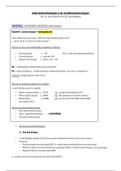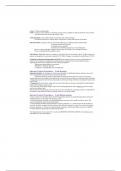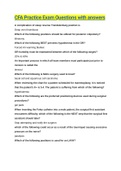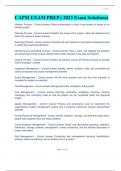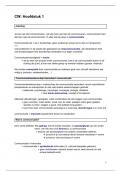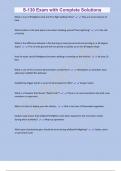Why food safety is so important?
To avoiding food contamination and outbreaks, to make sure that the food preparation,
transport and storage were done properly
Where food safety legislation applies?
Food premises
Federal legislation
Take care of foods and drugs, alteration, colouring and bacterial standars
Provincial legislation
Take care of condition and safety under which food in held, prepared and server to the
public
Municipal legislation
Take care of licensing, garbage control, sewage disposal, building standard and zoning
Responsibilities of food premise owners and operators
Keep the food safe such as cleaning, wearing cleaning outer garments and safe
environment
Benefits of following safe food handling practices
Customers went places with safe food, no need to spend money on lawsuits, lower
insurance costs, happier customers and not wasting money by throwing food away .
Common symptoms of food borne illness
Stomach cramps, nausea, diarrhea, vomiting, fever and headache.
When foodborne illness is food poisoning?
Cause by chemicals such as cleanser or even sulphites or monosodium glutamate
(MSG)
3 Types of chemical food poisoning
Metal (dissolved metal in food), Intentional additives (products to add color, thicken, firm
or preserve food) and Incidental additives (poisonous chemical such as insecticides,
rodenticides or cleaning chemicals)
Dangers and types of physical hazards in food
Dirt, hair, nails, bits of metal. These. can cause from small cuts to chocking
The impact of foodborne illness on people and businesses
Medical costs, investigation costs, loss of productivity, sicking people missing work,
legal and insurance costs
Microorganisms that can be good for us
Yeast (used to make bread and produce alcohol), Bacteria (used to help us digest food)
and Mould (used to ripens and flavours cheese such as blue cheese)
Types of pathogenic microorganisms that causes food borne illness
Viruses, parasites, yeasts, mould and bacteria
, What`s similar and what`s different about pathogens?
Viruses (the most common way is from human hands) and Parasites (contaminated
water) don`t grow in food. Yeasts (need moisture and sugar), mould (colonies are fuzzy)
and bacterias (good: lactobacillus and harmful: salmonella - raw poulty and eggs; E.
Colli - under cooked meat and water)
Sources of microorganisms
Proteins such as fish, poultry. Dairy, foods at 4°C to 60°C temperature, contaminated
water, human hands, cross-contamination.
Foodborne illnesses pathogenic can causes
Hepatitis A, avian flu, rotavirus, toxins, salmonella, E. Colli and botulinum
Symptoms of foodborne illnesses
Nausea, headache, stomach pain, diarrhea, muscle weakness, vomiting, dizziness and
even death.
Why some kinds of food contamination are more likely than others to make
people sick?
Because they have potentially hazardous (moist foods, pH above 4.5, dairy products,
meat, fish, poultry, eggs and some raw fruits and vegetables.
Why are some people more likely to get sick than others?
They are part of the risk group: young children, elderly, pregnant and weak immune
system people, also the amount of pathogen in food, type of microorganism (protozoa
are more likely to cause illness)
How carries can transfer microorganisms to food?
Basically through hands and cross-contamination (pass from one type of food to
another)
What bacteria needs in order to grow up?
Foods at 4°C to 60°C temperature, oxygen or lack of it, pH above 4.5, moisture and
protein.
What makes a food potentially hazardous?
Moist foods, pH above 4.5, dairy, meat, fish, poultry, eggs, raw fruits and vegetables.
When do you need to recalibrate your probe thermometer?
After an extreme temperature fall and If it`s has been dropped.
How do you recalibrate your probe thermometer?
1- Mix a 50/50 of crushed ice and water in a container. The temperature should be
always 0°C 2- Set the probe thermometer in the mixture and be sure it isn`t touching
sides or bottom and wait until the needle stops moving. If it`s not 0°C must be adjusted.
3- Adjust and keep the thermometer int the mixture to make sure it`s accurate.
The correct temperature to store frozen and refrigerated foods
Frozen must be -18°C and refrigerated must be kept at 4°C or lower.
Safe methods to thawing foods
In the refrigerator at 4°C (it takes 10h/kg), in a sink with cold running water, as part of a
continuous cooking process or in the microwave.

